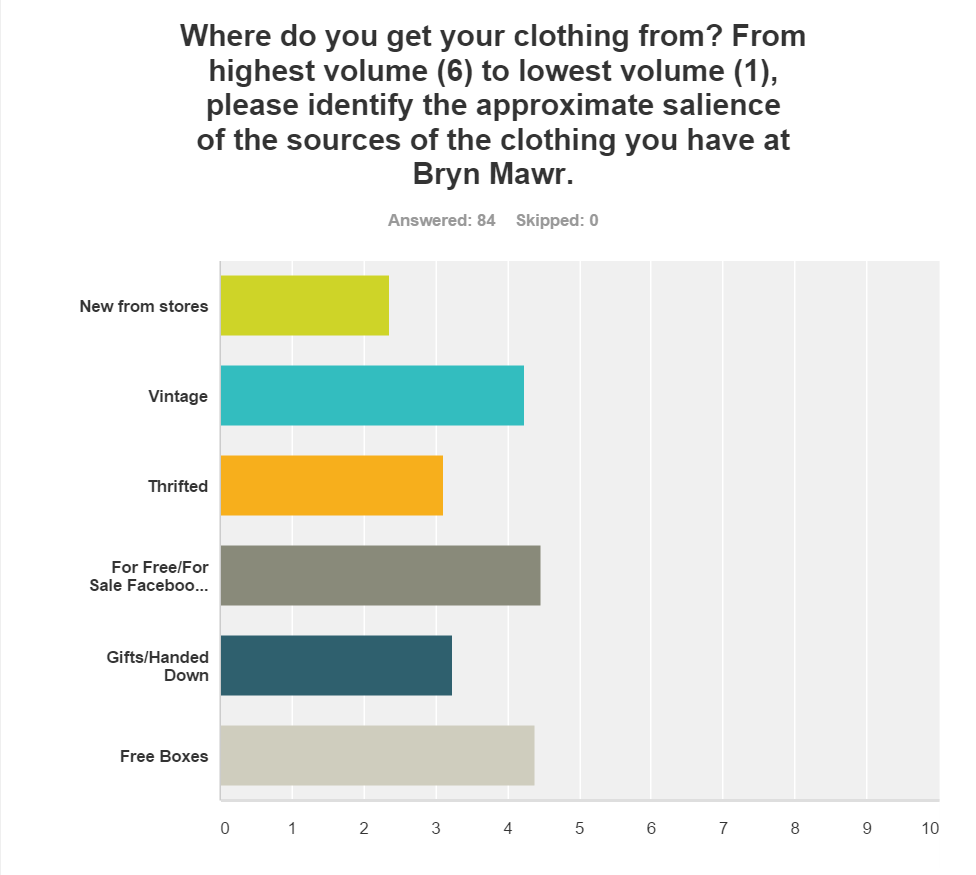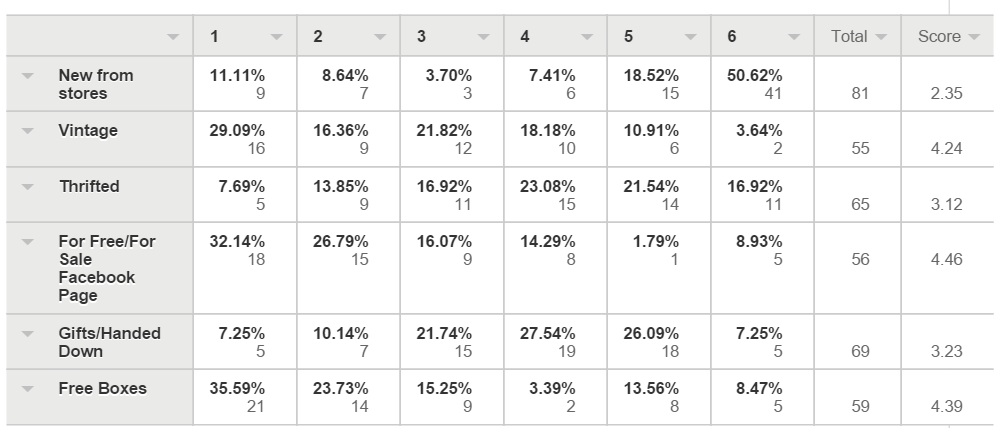December 8, 2015 - 08:56

Marking and Masking Identity through Clothing: Exploration of the Effects of Style and Appearance on BMC Interactions
My partner, Angela, and I worked together to figure out the salience of clothing and style in shaping Bryn Mawr as a contact zone. While Angela on the contact zones surround the For Free/For Sale Page and Free Boxes around campus, I focused on the social impacts of how people dress themselves, and how the social interactions at Bryn Mawr shaped how they dress themselves.
One part of my research was an anonymous survey, which really helped to pull my facet of the topic together with Angela's. Here is a screenshot of the data we collected. I posted in the Bryn Mawr College Class of 2019 Facebook page. I also posted it on my main facebook page and it was shared by another Bryn Mawr first-year to her Facebook wall.
Of the people who answered the survey:
57 had been at Bryn Mawr from 0-1 years
5 for 1-2 years
12 for 2-3 years
5 for 3-4 years
5 for 4+ years
We were very suprised to find that such a high volume of clothing appeared to come from For Free/For Sale or Free Boxes.
The other part of my research was through interviews. These ranged in detail from taking 5 minutes to 4 hours. All the people I identified were Bryn Mawr students, and there were subjects from all four classes. The majority of my most in-depth interviews were with people who I targeted as having interesting style in my own opinion, but I also ended up asking questions to more randomized groups of people.
Each conversation I had had three main points, with follow up questions in addition as the dialogue progressed.
- How would you describe your personal style?
- Do you feel you express your personality through your style? To what extent do you mark or mask your identity through your style and appearance?
- How do you feel that you judge and interact with people based on their style and appearance?
Most of my participants did not answer the first question with an identity-based response, but a couple upper classmen included descriptions of their identity within the phrase they used to describe for their personal style, pulling "queer" in as a motif to their appearance. Those tended to be the conversations more driven by discussions of identity and privelege
Not everyone had a strong reaction to question number two, but at the root of it even those who shied away from saying that their style was a large part of them tended to include some descriptor of how it reflected who they were: ethnicity, geographic background, presentation of gender and sexuality, even just that they thoguht they were a laid-back person and that their sweatpants reflected that.
Even the people who didn't feel like they were especially representative of their identity via style said they were drawn to people with what they read as a similar approach or presentation of identity to themselves. Across the board, people judged based on appearance. Most people who said this blatantly were then harsh on themselves for judging people on something so "superficial." One participant, a first year, said they were drawn to people who dressed "eccentrically," even though described themselves as a deliberate but non-provocative dresser. She said it read as them being confident, unique, and interesting, and brough up the word "infatuation" in regards to this. Another participant, who said she cared very much about clothing and style, said that she viewed people who were interesting in the way they dressed as thinking in a similar way to the way she did. Not so much identity solidarity, but mind solidarity.
I was also able to have a lot of interesting conversations about parties and dressing for parties. This typically prompted comparisons between Bryn Mawr and the other schools in the Quaker Consortium, which led to discussions about Bryn Mawr as a safe space. In a discussion about dressing up for Batten parties, conversations turned to who goes to these parties. Batten tends to be primarily Bryn Mawr students, and often, in my experience and from what others have told me, is where style tends to be the most interesting. "They feel the most Bryn Mawr." And, so, when students who aren't Bryn Mawr studnts come to those parties, especially cis straight men, some of my participants felt like their home was being intruded. It came back to a sense that as Bryn Mawr students there was some level of coming into the space with the same ideals, of, mostly, respect and empowerment (one participant mentioned the cheer "Hey Hey Ho Ho the Patriarchy Has Got To Go"). While they acknowleged that this wasn't the case of students of all identities and backgrounds here, I thought the dialogue about what a safe and accomadating space is, and Bryn Mawr parties fitting into that as a place to heal and relax and play, really had a place in this research.
Many of the people I interviews talked about dressing up as cathartic. Their clothes didn't just represent their identities but their moods. Many people talked about "playing dress up" as a form of self-care. In this way, being able to dress freely for Batten parties took on a new spin; Healing happens through community, which is why we have womens' colleges. "Home should feel like your community to heal." But when the home felt invaded by a critiquing or assuming gaze, especially one that traditionally sexualizes and objectifies, that safety felt invaded.
Bryn Mawr and safety in regards to style was a common thread. Many people felt like they could be more free to be themselves or more interesting with their clothing at Bryn Mawr than at other places, hometowns included. However, many people talked about the feeling pressures or stresses from the Bryn Mawr community, as well. One participant spoke about feeling like she had to keep up appearances now that people were expecting interesting looks from her. Another spoke about representing her country well. In discusions about marking queer identity through one's appearance, a lot came up about fitting into certain roles within the queer community, such as butch or femme, and the pressure from the community not only to choose a role and fit into it, but that there was so much riding on one's outward appearance.
A couple people talked about how how they dressed affected how they were viewed in the queer community here. First, there were references in one interview to "that Bryn Mawr queer," a person with a slghtly grungy air, a flannel, and a short crop. The "Bryn Mawr Chop" in general brought up some interesting discussions of pressure from within the queer community, such as to "just cut your hair already," and other general sexualization of first-years. There's something really interesting there about the conflicts that Bryn Mawr creates in trying to be so progressive and open. One student, who presents as black, but has intense cultural roots with India, spoke about wearing her salwar kameez, a traditional causal Indian outfit, here at Bryn Mawr. While that is what she felt most comfortable and most herself in, once an Indian woman in her class asked her "if [she] was trying to dress Indian," she suddenly became uncomfortable due to feelings of possible cultural appropriation and disrespect.


